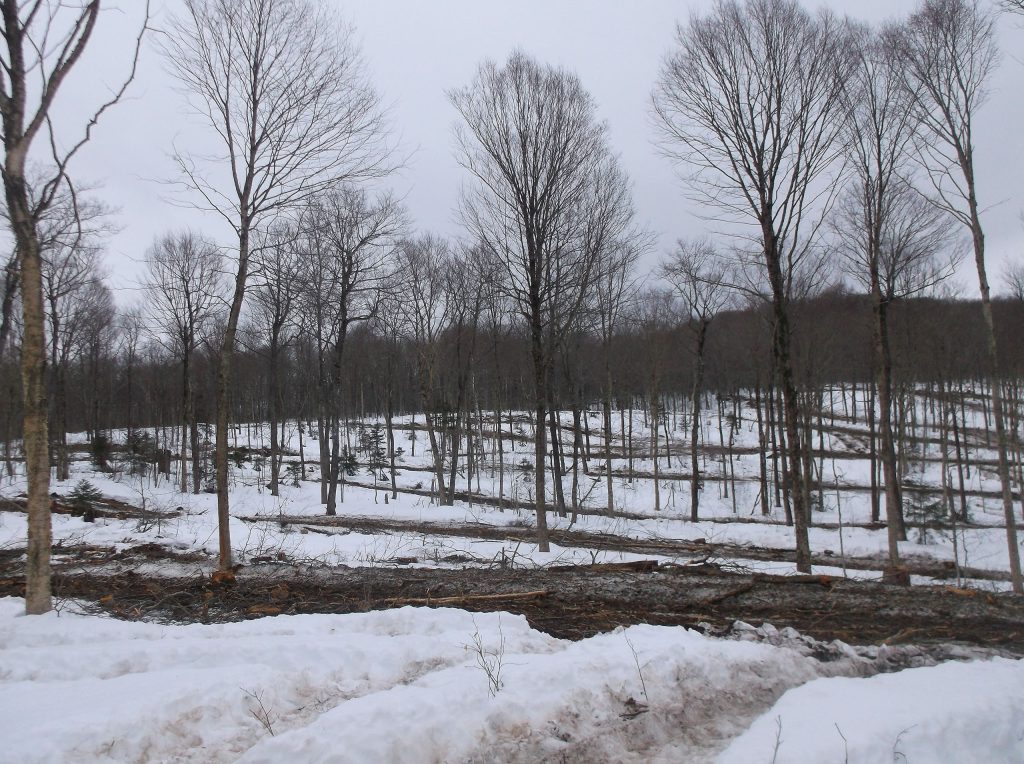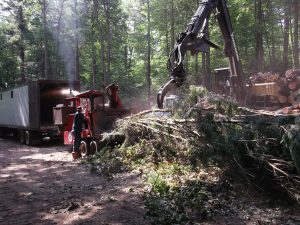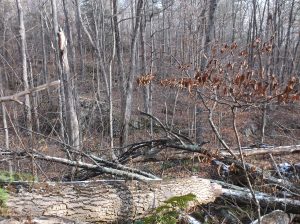Biomass
Biomass: Controversy and Misconceptions
By Robbo Holleran

If you are a regular reader of this magazine, you probably know a little about biomass, and perhaps a great deal. I hope to add to that, provide some encouragement, and address some of the controversial aspects. Some say that biomass energy is bad for the environment and the atmosphere, and some say it is an important tool for forest management. The main opposition comes in three categories: the efficiency of producing heat or, more specifically, electricity from wood; forestry practices and sustainability; and emissions such as particulates and carbon dioxide.
I have been able to do some great forestry with biomass harvesting. Landowners like the clean result with the debris gone, and cull trees removed. The logging is productive, and the crews tend to be professional. We are able to remove very high proportions of cull material, and this is especially pertinent for proper regeneration harvesting in Northern Hardwood stands. We have many forest management plans that cannot be implemented without biomass markets.
Misleading Industry Terminology

Instead of “whole tree chips,” we should be using terms like “waste wood chips,” “forestry by-products,” or “logging residue.” Seldom is a whole tree chipped for biomass, unless there is not a better market for that tree. The general public is left with the impression that we are chipping the whole tree – and by implication – the whole forest to make electricity.
We use the term “whole-tree logging” when the whole tree is dragged to the roadside to be processed, instead of being processed at the stump as with conventional logging. At the landing, sawlogs, pulp, and firewood are taken as available from each tree. Each of these products is more valuable than the chips in most cases. Just the tops, scraps, and branches are chipped, so this is really a “forestry by-product.” This becomes more important when we talk about carbon accounting.
Heat and Electricity from Wood
When we speak of “biomass energy” there are several categories to include. Burning split firewood or pellets is part of this discussion and has a significant impact in the northeast region. Chips are burned for energy in several forms, including stemwood chips in medium-sized boilers for heat, and larger-scale electric generation with waste-wood chips.
Modern heating systems using pellets or stemwood chips are more than 80 percent efficient and clean burning. The controversy here relates to the perception of wood burning as dirty, and a misunderstanding of the truly renewable and sustainable aspect of modern wood heat. Many states in the region have policies that promote wood burning at small and medium scale because they recognize that these systems are clean, and that wood harvesting promotes good forestry.
Middlebury College is one example on the larger end of the scale. They have a modern wood-gasification system that heats essentially the whole campus on about 20,000 tons of wood chips per year. They advertise the sustainability benefits of a 40 percent net reduction in emissions of carbon, the huge cost savings, and the benefits to the local economy. They also point out that the carbon is “biogenic,” meaning that it comes from carbon that was previously in the atmosphere and taken up by forest growth, and it is clearly renewable, sustainable, and carbon neutral based on forest growth in the region.
Large-scale electric generation with waste wood chips is more controversial. Part of the political scrutiny is that burning wet wood chips is inherently inefficient. If the “spent steam” is not used for another purpose, making electricity can be as low as 25 percent efficiency. While these plants are extremely clean burning for particulates and gasses, the perception is that they are “dirty.” There is a smokestack, but most of what comes out is just steam. Burlington, Vermont has a large facility that burns 400,000 tons of green chips per year, or almost two tractor-trailer loads per hour. This is enough to power most of the city, and they can boast about their clean air and renewable power. There is a proposal to use the spent steam for heat on the UVM campus, which would boost the efficency.
Biomass and Forest Management
Biomass markets have given landowners the option of removing low-grade material: cull trees, tops, and branches, without better market options. Much of our cull material is not even suitable for pulp. The result is a much cleaner woodlot than conventional logging, which would take the round logs suitable for market, and leave this waste scattered around to rot. Whole-tree logging is extremely efficient and less dependent upon tree size for logging cost. This allows landowners to implement their management plans, especially to improve the proportion of high-quality growing stock, or to regenerate poor-quality stands, which increases the value of the subsequent growth. Having the occasional income from periodic harvesting allows the ordinary citizen the extraordinary opportunity to own forestland, improve wildlife habitat, and hopefully, to pass this on to their heirs. These forestry practices are highly controlled by the various state laws, forest management plans, and licensing of foresters and timber harvesters in some states.

Public perception of excessive biomass harvesting does not come from the official inventory figures. Opponents will say that logging for biomass is excessive and unsustainable. They do not understand that many of our forests are mature or low quality, and that regenerating these forests properly is an important part of forest - and wildlife habitat - management. Forests are growing faster than harvest in every state in the northeast. The occasional heavy cut along a well-traveled road distorts their perception. Whole-tree logging tends to have large, messy landings, and this is the “face” of our industry. They see trucks tracking mud onto the highway and slowing down traffic. And they hear sound-bites about “leaving forests natural” for carbon reasons.
From a practical perspective, we can do a lot to keep our landings neat, or build a hundred yards of truck road to get the landing out of sight. Try to keep mud off of the highway, and warn traffic about heavy trucks entering. Clean up and seed your landing promptly for appearance’s sake. Sometimes I will put up signs to let the visitors know that the harvest was part of a well-thought-out forest plan. I usually get great feedback from these, and if someone has a negative first impression, they are left with another way of looking at it.
The Carbon Issue
The heavy public opposition to biomass – and tree harvesting in general – comes from the carbon issue. Whether or not you think that carbon is a pollutant, this is important to public policy, which determines whether we can do our business. Forest management is carbon management. We should be ready and willing to address our neighbors with the thought that managing forests is good for the environment, and that it is good carbon management. From a carbon perspective, forestland is the very best land use, and we can make a strong argument that good forest management provides a crisp economic incentive for forests to stay forested, and not be converted to other uses.
The basic carbon cycle is fairly easy to explain. The details get complicated. As trees grow, they pull carbon dioxide out of the air and combine it with water to create sugars and release oxygen. That is wonderful. Trees also burn sugars, using oxygen and releasing CO2. The extra sugars get converted to cellulose and other chemicals that form the wood in the tree. We measure that as the growth in the forest, in cords, boards, and tons. Of course, there are roots underground, dead trees, and partially decayed organic matter which adds to the forest’s carbon storage. When trees die, they slowly release their carbon, and use up the same amount of oxygen they produced. When we harvest trees, most of the wood is on a short cycle to be burned or disposed of in some way that returns the carbon to the atmosphere. A portion ends up as “durable wood products” like housing or furniture which might store the carbon for a century or more. Accounting for this entire carbon cycle can be incredibly complex.
From a shallow perspective, if forests store carbon, then the more they have, the better. Some people would like to see the forests dedicated to storing as much as possible. And they are correct that a well-managed forest will have slightly lower levels of carbon, which essentially means more forest carbon will be released to the atmosphere. And they are correct to state that it takes more carbon to make a kilowatt of electricity from wet wood chips than from dry coal. But there is more to the story.
To address these points, we should understand two competing issues in forestry: the current carbon storage and the rate of growth. Opponents like both of these, but don’t seem to understand how they conflict. A mature, fully-stocked forest will have a lot of stored tons per acre, but a very low rate of additional growth. Most of our forests have this situation. Crowded forests are still growing, but have a high rate of mortality, which releases carbon back into the atmosphere with little net gain. In Vermont, for example, close to a million cords dies and rots each year. This has the same carbon effect as a 30,000-acre forest fire every summer. If it burned instead of rotting, everyone would notice. Younger and middle-aged forests, especially with recent thinning, will have the highest rates of additional growth, but lower storage per acre. This is just common sense to us forestry people.
If we did not use wood products, then storing carbon in forests would be a good idea. But our forests are more valuable to carbon management than merely storage. Wood is good. We should promote the environmental and carbon benefits of using wood as a raw material. It is renewable, recyclable, biodegradable, and usually organically grown. It is often grown in diverse forests which provide a myriad of other social and environmental benefits. It takes less carbon-based energy and causes less pollution to process wood into final products compared to almost all other materials, and these durable wood products can store carbon for centuries. A true environmentalist should insist that we use more wood and not less. And certainly, we should harvest our wood locally, where the stewardship is at a high level, compared to bringing our wood from Indonesia or Brazil, where the standards are not so high.
The carbon benefits of using wood are dramatic. A steel chair needs to be mined as ore, refined, processed, painted, and shipped from somewhere far away, all based on fossil fuels. A wooden chair can be made from a tree in your town, sawn locally, and processed using far less energy. So, the carbon stored in that chair is incidental, but the alternative raw material is the main accounting item. Charles Levesque at INRS has published some numbers on this. The study compared the fossil fuel use of three types of supporting floor used in construction. It concludes that compared to traditional wood framing, a concrete floor uses about 2.5 times as much, and a steel floor uses almost 5 times as much. Aluminum is far worse.
The Case for Biomass
Once we decide that we should manage our forests wisely, and use wood where appropriate as a raw material, then the conclusions about biomass are easy. Biomass is merely a byproduct of growing and harvesting better trees. We should manage forests to minimize their natural mortality and natural carbon release. This will naturally lead us to a more balanced set of age classes, with younger forests growing fast, and healthy older forests storing carbon. We should be culturing these forests toward valuable long-lived species that are most likely to be made into durable wood products. By replacing more carbon-intensive materials with wood, we have a carbon benefit.
While tending and regenerating these forests, we will be harvesting competing trees that are best used for firewood, pulpwood, and biomass energy. The tops and branches are truly by-products or forest waste. Using them for energy, even at relatively low efficiency, replaces fossil fuels with another carbon benefit. This is a significant source of non-fossil energy in the Northeast.
By burning biomass, we provide a reliable, renewable, homegrown source of fuel without adding fossilized carbon to the atmosphere. We keep energy dollars in the community, with hundreds of family-wage jobs. We assist landowners with a substantial tool for forest management, which encourages investment in growing forests for higher-value products and keeping the land in forest use for another generation. These principles are easily integrated with other forestry goals, and forests are much more than merely stored carbon.
Robbo Holleran is a consulting forester based in Vermont and licensed in three adjacent states with 40 years of experience. He is an active writer, speaker, and teacher on a wide range of forestry issues. He shares an Outstanding Leadership in Industry Award from NELA with Steve Hardy.
